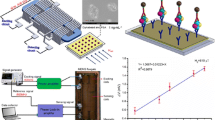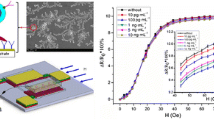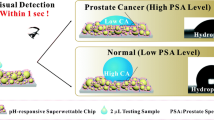Abstract
This paper presents a contactless detection method for detecting prostate specific antigen with a giant magnetoresistance sensor. In contactless detection case, the prostate specific antigen sample preparation was separated from the sensor that prevented the sensor from being immersed in chemical solvents, and made the sensor implementing in immediately reuse without wash. Experimental results showed that applied an external magnetic field in a range of 50 Oe to 90 Oe, Dynabeads with a concentration as low as 0.1 μg/mL can be detected by this system and could give an approximate quantitation to the logarithmic of Dynabeads concentration. Sandwich immunoassay was employed for preparing PSA samples. The PSA capture was implemented on a gold film modified with a self-assembled monolayer and using biotinylated secondary antibody against PSA and streptavidinylated Dynabeads. With DC magnetic field in the range of 50 to 90 Oe, PSA can be detected with a detection limit as low as 0.1 ng/mL. Samples spiked with different concentrations of PSA can be distinguished clearly. Due to the contactless detection method, the detection system exhibited advantages such as convenient manipulation, reusable, inexpensive, small weight. So, this detection method was a promising candidate in biomarker detection, especially in point of care detection.







Similar content being viewed by others
References
M. S. Arana, E. Casta˜noa, M. Tijero, R. Vilares, J. M. Ruano-López, A. Cruz, L. Sainz, J. Berganza, Biosens Bioelectron 24, 1253–1258 (2009)
D. R. Baselt, G. U. Lee, M. Natesan, S. W. Metzger, P. E. Sheehan, R. J. Colton, Biosens. Bioelectron 13, 731–739 (1998)
Y.R. Chemla, H.L. Crossman, Y. Poon, R. McDermott, R. Stevens, M.D Alper, J. Clarke. Proc. Natl. Acad. Sci. U.S.A., 97, 14268–14272. (2000)
K. Chuah, L. M. H. Lai, I. Y. Goon, S. G. Parker, R. Amal, J. J. Gooding, Chem. Commun. 48, 3503–3505 (2012)
J. Devkota, G. Kokkinis, M. Jamalieh, M. H. Pan, H. Srikanth, S. Cardoso, F.A. Cardoso, I. Gioiroudi. Proc. SPIE 9518, Bio-MEMS and Medical Microdevices II, 95180 W (2015).
R. L. Edelstein, C. R. Tamanaha, P. E. Sheehan, M. M. Miller, D. R. Baselt, L. J. Whitman, R. J. Colton, Biosens. Bioelectron 14, 805–813 (2000)
H. A. Ferreira, D. L. Graham, P. P. Freitas, J. M. S. Cabral, J. Appl. Phys 93, 7281–7286 (2003)
D. L. Graham, H. A. Ferreira, P. P. Freitas, J. M. S. Cabral, Biosens Bioelectron 18, 483–488 (2003)
H. Grönberg, Lancet 361, 859–864 (2003)
D. Issadore, Y. I. Park, H. Shao, C. Min, K. Lee, M. Liong, R. Weissleder, H. Lee, Lab on a Chip 14(14), 2385–2397 (2014)
K. Ito, W. Nishimura, M. Maeda, et al., Analytica chimica acta, 588, 245–251 (2007)
P. Jolly, N. Formisano, J. Tkac, P. Kasak, C. G. Frost, P. Estrela, Sens. Actuators B:Chem. 209, 306–312 (2015)
C. Kokkinos, A. Economou, P. S. Petrou, S. E. Kakabakos, Anal. Chem. 85, 10686–10691 (2013)
C. B. Kriz, K. Radevik, D. Kriz, Anal Chemial 68, 1966–1970 (1996)
S. Lee, W. R. Myers, H. L. Grossman, H. M. Cho, Y. R. Chemla, J. Clarke, Appl. Phys. Lett 81, 3094–3096 (2002)
G. Li, S. X. Wang, IEEE Trans Magn 40, 3000–3002 (2004)
H. J. Linton, L. S. Marks, L. S. Millar, C. L. Knott, H. G. Rittenhouse, D. SMikolajczyk, Clin. Chem 49, 253–259 (2003)
K. Matsumoto, N. Konishi, Y. Hiasa, E. Kimura, Y. Takahashi, K. Shinohara, T. Samori, Clin. Chim. Acta 281, 57–69 (1999)
M. M. Miller, P. E. Sheehan, R. L. Edelstein, C. R. Tamanaha, L. Zhong, S. Bounnak, L. J. Whitman, R. J. Colton, J magnetism Magn mater 225, 138–144 (2001)
M. Mujika, S. Arana, E. Casta˜noa, M. Tijero, R. Vilares, J.M. Ruano-López, A.Cruz, L. Sainz, J. Berganza, Biosens Bioelectron 24, 1253–1258 (2009)
H. Özen, S. Sözen, Eur. Urol. Suppl 5, 495–499 (2006)
C. Y. Poon, H. M. Chan, H. W. Li, Sens. Actuators B:Chem 190, 737–744 (2014)
G. Rieger, K. Ludiwig, J. Hauch, W. Clemens, Sensors Actuators A Phys. 91(1), 7–11 (2001)
J. C. Rife, M. M. Miller, P. E. Sheehan, C. R. Tamanaha, M. Tondra, L. J. Whitman, Sens actuators a 107, 209–218 (2003)
J. Schotter, P. B. Kamp, A. Becker, A. Pühler, G. Reiss, H. Brückl, Biosens. Bioelectron. 19(10), 1149–1156 (2004)
M. Tondra, M. porter, R. J. Lipert, J. Vac. Sci. Technol 18, 1125–1129 (2002)
S. X. Wang, G. X. Li, Advances in magnetics. Vol 44, 1687–1702 (2008)
S. X. Wang, S. Y. Bae, G. Li, S. Sun, R. L. White, J. T. Kemp, C. D. Webb, J Magn Magn Mater 293, 731–736 (2005)
L. Zhao, L. Sun, X. Chu, Trends in. Anal. Chem. 28, 404–415 (2009)
X. Zhi, M. Deng, H. Yang, G. Gao, K. Wang, H. L. Fu, Y. X. Zhang, D. Chen, D. X. Cui, Biosens Bioelectron 54, 372–377 (2014)
Acknowledgments
This work is supported by The National Natural Science Foundation of China (No.61273065), National Science and Technology Support Program (2012BAK08B05), Natural Science Foundation of Shanghai (13ZR1420800), Support fund of Shanghai Jiao Tong University (AgriX2015005), Support fund of Joint research center for advanced aerospace technology of Shanghai Academy of Spaceflight Technology-Shanghai Jiao Tong University (USCAST2015-2), Support fund of aerospace technology (15GFZ-JJ02-05), the Analytical and Testing Center in Shanghai Jiao Tong University, the Center for Advanced Electronic Materials and Devices in Shanghai Jiao Tong University.
Author information
Authors and Affiliations
Corresponding authors
Electronic Supplementary Material
ESM 1
(DOCX 478 kb)
Rights and permissions
About this article
Cite this article
Sun, X., Zhi, S., Lei, C. et al. Investigation of contactless detection using a giant magnetoresistance sensor for detecting prostate specific antigen. Biomed Microdevices 18, 60 (2016). https://doi.org/10.1007/s10544-016-0084-9
Published:
DOI: https://doi.org/10.1007/s10544-016-0084-9




